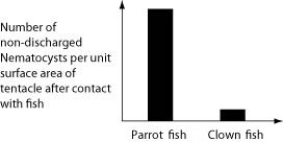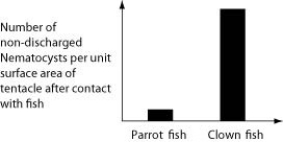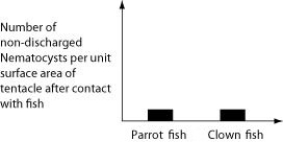Multiple Choice
A primary school science teacher decided to liven up the classroom with a saltwater aquarium. Knowing that saltwater aquaria can be quite a hassle, the teacher proceeded stepwise. First, the teacher conditioned the water. Next, the teacher decided to stock the tank with various marine invertebrates, including a polychaete, a siliceous sponge, several bivalves, a shrimp, several sea anemones of different types, a colonial hydra, a few coral species, an ectoproct, a sea star, and several herbivorous gastropod varieties. Lastly, she added some vertebrates-a parrot fish and a clown fish. She arranged for daily feedings of copepods and feeder fish.
-Normally, the clown fish readily swims among the tentacles of the sea anemones; the parrot fish avoids them. One hypothesis for the clown fish's apparent immunity is that they slowly build a tolerance to the sea anemone's toxin. A second hypothesis is that a chemical in the mucus that coats the clown fish prevents the nematocysts from being triggered. Which of the following graphs supports the first, but not the second, of these hypotheses?
A) 
B) 
C) 
D) 
Correct Answer:

Verified
Correct Answer:
Verified
Q1: Molecular studies have changed many of the
Q15: Which of the following organisms would you
Q31: Healthy corals are brightly coloured because they
Q36: The nontaxonomic term sea slug encompasses a
Q39: The water vascular system of echinoderms _.<br>A)
Q40: Soft-shell crab is a prized dish in
Q43: Which characteristic is shared by cnidarians and
Q50: Which of the following statements is correct
Q54: One should expect to find cilia associated
Q64: Nematodes and arthropods both _.<br>A) develop an